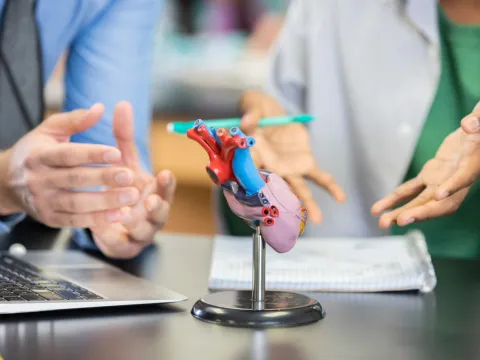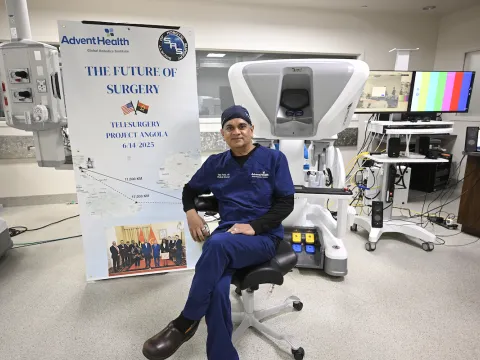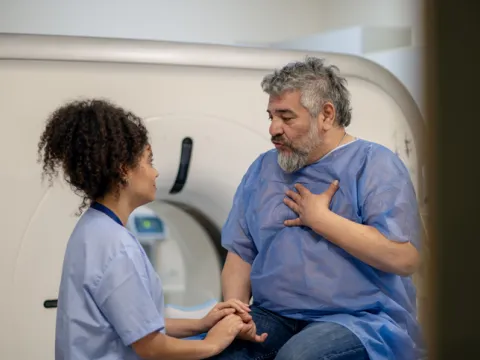- AdventHealth

Executive Medical Director of Orthopedic Surgery
Rothman Orthopaedics Florida at AdventHealth
This Clinician's View is written by Daryl C. Osbahr, MD, Chairman & Executive Medical Director of Orthopedic Surgery, Rothman Orthopaedics Florida at AdventHealth
Anterior cruciate ligament (ACL) injury has been a historically devastating injury in competitive sports. Despite the notion that modern-day surgical techniques and rehabilitative pathways portend a consistent pathway for a successful short-and long-term outcome, ACL re-injury, rates of subsequent surgery, and risk for long-term arthritis remain significant issues that young athletes will often ultimately battle.
Although surgical management of ACL injuries has continued to advance through evolving ACL reconstruction and preservation surgical techniques, gaps and inconsistencies in the use of innovative rehabilitative pathways to optimize outcomes remain. Our team at Rothman Orthopaedics Florida at AdventHealth believes there is a tremendous opportunity for multidisciplinary providers to come together and create a better, collaborative approach to ACL injury recovery. To that end, we are working on an evolving concept for ACL injury risk mitigation based on the previously described Control-Chaos Continuum. Combining a multidisciplinary clinical and academic approach, it focuses on aligning visual-cognitive, neuro-cognitive, neuromuscular, and sports performance progression variables as an athlete strives to maximize all recovery options with the goal of successfully progressing from the bench to the field.
Addressing the Long-Term Impacts of ACL Injury
Not only are young athletes at the highest risk of incurring an ACL injury, but the effects can also persist, predisposing them to additional knee injuries and osteoarthritis. In fact a recent systematic review and meta-analysis of anterior cruciate ligament injury risk, determined that athletes younger than 25 years of age who return to sport have a secondary ACL injury rate of 23%. This includes both ipsilateral re-injury (same knee) and contralateral re-injury (opposite knee). Those who participate in the highest-risk sports like soccer and football may experience even higher re-injury rates.
Additionally, it has been estimated that at least 1 in 3 young patients who experience a knee injury face the challenges of living with knee osteoarthritis for most of their lives. This can result in reduced quality of life, diminished physical activity levels, and decreased physical function as well as corresponding psychosocial and comorbidity concerns like depression or cardiovascular disease.
At Rothman Orthopaedics Florida at AdventHealth, we are working to harness the power of innovation and collaboration to improve these outcomes.
The Control-Chaos Continuum — Preparing Athletes for Spontaneous and Unanticipated Movements
The Control-Chaos Continuum (CCC) is an advanced concept that outlines the importance of assessing both quantitative and qualitative variables within a movement-based progression while also placing significant focus on the importance of integrating spontaneous and unanticipated movement patterns (i.e., control to chaos). It aims to prepare an athlete to be able to fully load and train all important visual, cognitive, and neuromuscular variables necessary for complex, unanticipated athletic activities that occur in real-life game situations.
CCC is based on a five-phase framework model which focuses on a criteria-based progression toward spontaneous and unanticipated movement:
- High control
- Moderate control
- Control to chaos
- Moderate chaos
- High chaos
The initial CCC concept centered on an athlete’s subjective assessment of readiness to move to the next phase in the setting of certain fitness variables as evaluated by the medical and performance teams. However, evolution of the CCC concept over time has led to significant advancements through the integration of critical neuroplasticity measures and interventions for criteria-based progression utilizing visual-cognitive (VC-CCC), neuro-cognitive (NC-CCC), and neuromuscular (NM-CCC) concepts.
Most modern-day “advanced” ACL injury risk mitigation protocols consider basic NM-CCC concepts which focus on muscular strength, static and dynamic single
leg control, and subsequent complex movement pattern optimization in controlled and less often uncontrolled (i.e., chaotic) situations. However, next-level concepts for integration of VC-CCC and NC-CCC concepts is rarely incorporated into return-to-play protocols despite growing evidence outlining the important role they play in optimizing recovery and preventing re-injury.
Integrating Visual-Cognitive and Neuro-Cognitive Pathways to Maximize Performance and Minimize Injury
To effectively minimize negative leverage and load while also being able to react to an
unanticipated movement (i.e., chaos), the body must ultimately function as a force reducer while moving into single leg stability movement but convert to a force producer while moving out of single leg stability movement (i.e., bungee cord). Proper movement quality should be in play when the athlete is creating maximal power for loading. This is the position of leverage where being an effective force reducer is critical to minimize the excessive extensor torques about the knee that can lead to dynamic valgus moments and subsequent ACL injury.
Within athletic moments, the challenge then becomes how the body can ultimately function in this environment while minimizing the impact of electromechanical delay in promoting proper reaction time and maintaining these appropriate movement patterns. With this understanding, we can then optimize movement patterns while incorporating essential NC-CCC (i.e., cortical & vestibular), VC-CCC, and NM-CCC (i.e., neuromuscular & somatosensory) inputs to properly build criteria-based protocols for ACL injury risk mitigation.
Recently, the impact of integrating visual-cognitive system dual-task challenges into the ACL injury recovery plan has been emphasized to understand and potentially reduce the development of subsequent negative compensatory neural strategies which could ultimately affect the ability to prioritize cognitive vs. physical performance. Therefore, the integration of the VC-CCC concept into rehabilitation strategies early in the ACL recovery period is now considered to be crucial in optimizing recovery, minimizing poor compensatory pathways, and maximizing performance and injury prevention.
Advancing the ACL Comeback Plan — Taking a Multidisciplinary Team Approach that Integrates Sports Performance
Based on all of these critical concepts, our Rothman Orthopaedics Florida at AdventHealth ACL injury multidisciplinary team under the leadership of Luke S. Oh, MD; Todd N. Furman, DPT, ATC, CSCS; Russell Gaither, MS, CSCS, PES, CES, CSNC, MHFA, and myself, believes the overall ACL Comeback Plan must incorporate not only rehabilitative strategies but also sports performance training to maximize ultimate readiness to return to play. Our innovative concept for ACL injury risk mitigation centers around the fundamental CCC model with incorporation of our multidisciplinary clinical and academic approach to aligning visual-cognitive, neuro-cognitive, and neuro-muscular progression variables.
We are currently developing and collaborating on research that will integrate motion analysis using our 3D motion lab and functional MRI technology to identify and assess NC-CCC, VC-CCC, and NM-CCC compensatory changes and pathways for subsequent improvement with the goal of enhancing functional recovery after ACL injury. In addition, we believe the incorporation of virtual reality into the motion analysis environment will enable us to artificially impact the control-to-chaos environment to further enable providers to identify any movement pattern issue prior to return to play.
ACL Comeback: Integration of Sports Performance into the Control-Chaos Continuum Model

At Rothman Orthopaedics Florida at AdventHealth, our ultimate goal is to create an ACL Comeback Plan that integrates all three critical pathways — visual-cognitive, neuro-cognitive, and neuromuscular — into an innovative sports rehabilitation and performance criteria-based timeline, building a system around all athletes to maximize performance and minimize re-injury risk. Our multidisciplinary team is excited to work with other ACL injury experts around the world on this initiative to help our athletes not only progress from the bench to the field but ultimately, to stay on the field playing the games they love.





